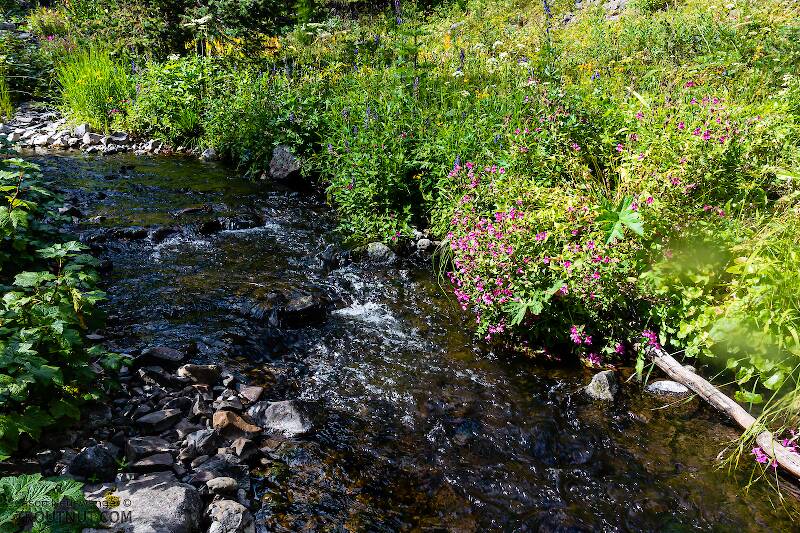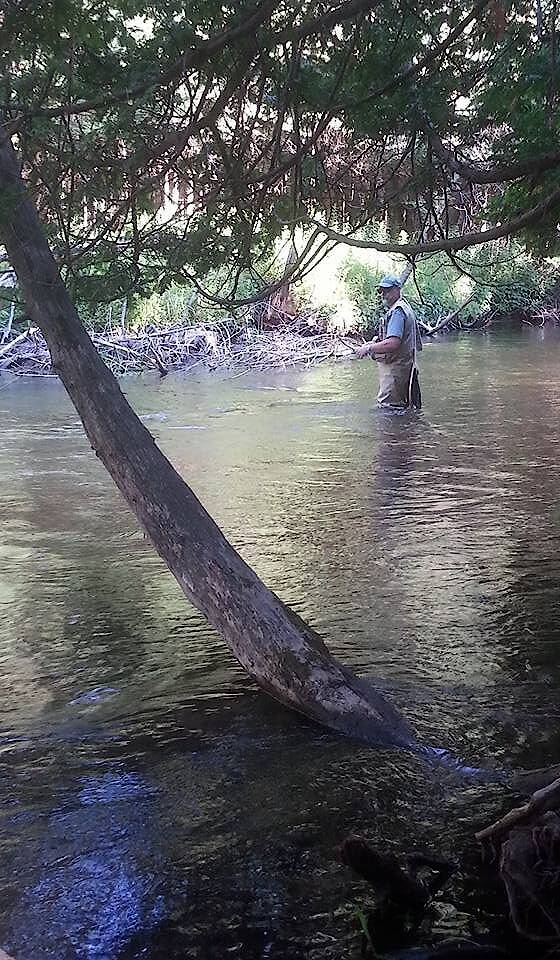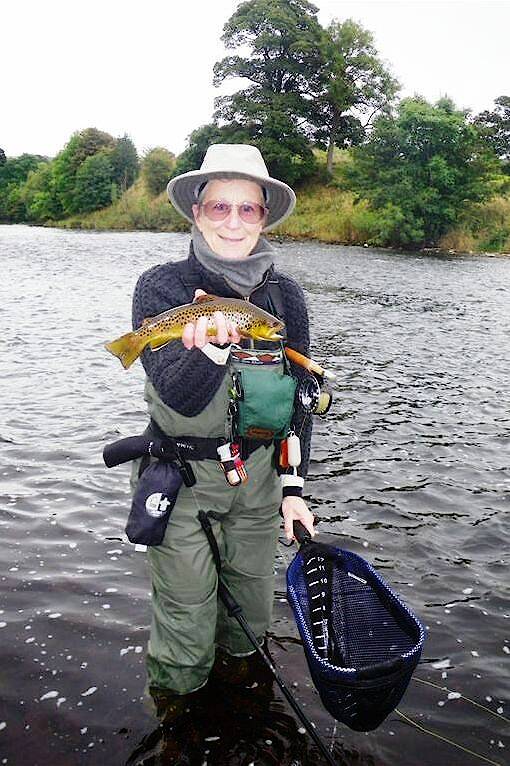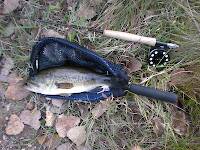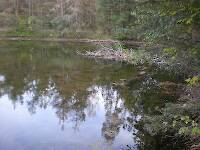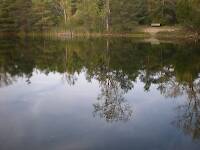
Blue-winged Olives
Baetis
Tiny Baetis mayflies are perhaps the most commonly encountered and imitated by anglers on all American trout streams due to their great abundance, widespread distribution, and trout-friendly emergence habits.
Featured on the forum

Nymphs of this species were fairly common in late-winter kick net samples from the upper Yakima River. Although I could not find a key to species of Zapada nymphs, a revision of the Nemouridae family by Baumann (1975) includes the following helpful sentence: "2 cervical gills on each side of midline, 1 arising inside and 1 outside of lateral cervical sclerites, usually single and elongate, sometimes constricted but with 3 or 4 branches arising beyond gill base in Zapada cinctipes." This specimen clearly has the branches and is within the range of that species.

Troutnut is a project started in 2003 by salmonid ecologist Jason "Troutnut" Neuswanger to help anglers and
fly tyers unabashedly embrace the entomological side of the sport. Learn more about Troutnut or
support the project for an enhanced experience here.
Roguerat on Aug 2, 2013August 2nd, 2013, 1:46 pm EDT
My 10-yr old grandson Caleb wants to start fly-fishing, after last winter spent in basic tying lessons followed by a half-dozen trips to the stream with grandpa over spring and early summer. I'm leaning toward an 8-ft medium-fast 5-wt with a 6 wt WF line, hoping this will load the rod more noticeably and make it easier to learn a casting stroke. Coupled with a click-pawl drag reel of medium price I hope this will make a good beginner outfit.
Has anyone gone through the whole process of working with a total novice, from equipment through casting lessons and then time on the river? I don't see this as anywhere near a daunting task; I'm really looking forward to it but want to do things right.
The Roguerat
I Peter 5:7 'Cast your cares upon Him...'
post-script..I returned from a couple trips lately (Little Manistee, then the White- the Michigan version) with the majority of fish caught being Chubs...imagine reading a post on this very quarry(?) when I got caught up on websites etc! By the way, Chubs are suckers for Epheron Leukon and Blue-Winged Olive dries!
Has anyone gone through the whole process of working with a total novice, from equipment through casting lessons and then time on the river? I don't see this as anywhere near a daunting task; I'm really looking forward to it but want to do things right.
The Roguerat
I Peter 5:7 'Cast your cares upon Him...'
post-script..I returned from a couple trips lately (Little Manistee, then the White- the Michigan version) with the majority of fish caught being Chubs...imagine reading a post on this very quarry(?) when I got caught up on websites etc! By the way, Chubs are suckers for Epheron Leukon and Blue-Winged Olive dries!
Martinlf on Aug 2, 2013August 2nd, 2013, 7:09 pm EDT
I'd think an 8 foot five weight would be just about perfect.
And there are some fine chubs in the Delaware too, if you get over this way. They'll take dry flies just as well as midwest chubs.
And there are some fine chubs in the Delaware too, if you get over this way. They'll take dry flies just as well as midwest chubs.
"He spread them a yard and a half. 'And every one that got away is this big.'"
--Fred Chappell
--Fred Chappell
CaseyP on Aug 3, 2013August 3rd, 2013, 12:21 pm EDT
having recently worked with 10-year-olds at TU Trout-in-the-Classroom releases, and with my lady-friend novices, i offer these (hard-learned!) tips:
small is good. my ladies loved the 6'6" 3wt medium action rod. a 7' 4wt was good too. the 9' 4wt wasn't as successful, being a bit harder for smaller arms and shoulders to manage.
kids need to catch fish. (you already know this!) casting practice on a bluegill pond is a heck of a lot more fun than on the grass. start on the grass for 15 minutes until he gets the hang of making the rod bend and the line follow it, and then switch to water with a foam spider.
[ladies, on the other hand, can get a lot of pleasure just making the line fly through the air--think rhythmic gymnastics.]
keep it short.
be sure to read this very old thread from this board in which Shawn discusses the frustrations of taking a (very small) child fishing. lots of good ideas there, even if your grandson is not small.
http://www.troutnut.com/topic/690/Advice-for-Taking-Little-Kids-Flyfishing
have a great time! there is nothing in this world more fun that someone else catching a fish because you helped.
small is good. my ladies loved the 6'6" 3wt medium action rod. a 7' 4wt was good too. the 9' 4wt wasn't as successful, being a bit harder for smaller arms and shoulders to manage.
kids need to catch fish. (you already know this!) casting practice on a bluegill pond is a heck of a lot more fun than on the grass. start on the grass for 15 minutes until he gets the hang of making the rod bend and the line follow it, and then switch to water with a foam spider.
[ladies, on the other hand, can get a lot of pleasure just making the line fly through the air--think rhythmic gymnastics.]
keep it short.
be sure to read this very old thread from this board in which Shawn discusses the frustrations of taking a (very small) child fishing. lots of good ideas there, even if your grandson is not small.
http://www.troutnut.com/topic/690/Advice-for-Taking-Little-Kids-Flyfishing
have a great time! there is nothing in this world more fun that someone else catching a fish because you helped.
"You can observe a lot by watching." Yogi Berra
Troutnut on Aug 3, 2013August 3rd, 2013, 12:57 pm EDT
I'd think an 8 foot five weight would be just about perfect.
During a millisecond of dyslexia when I first glanced at those words, I read it as "five foot 8 weight" and pictured a bunch of kids trying to cast with such a thing.
Jason Neuswanger, Ph.D.
Troutnut and salmonid ecologist
Troutnut and salmonid ecologist
Troutnut on Aug 3, 2013August 3rd, 2013, 1:11 pm EDT
small is good. my ladies loved the 6'6" 3wt medium action rod. a 7' 4wt was good too. the 9' 4wt wasn't as successful, being a bit harder for smaller arms and shoulders to manage.
I've got mixed feelings about this one. I guess it really depends on the context, whether you're trying to catch fish or just practicing casting, and how far you need to cast to get to the fish. It's true that a short, light rod is less fatiguing, but a larger rig (like an 8'6" 5-weight) is much easier to cast out to a medium distance, which is sometimes necessary to start catching fish.
Using a rod capable of a little bit of fatigue might be good for beginners, because I've found that when they get tired it's usually because of poor form. Everyone I can remember teaching has had a tendency to generate way too much of the casting motion with their wrist and not enough with their arm, and that causes soreness quickly. I think I did this when I first started, too. They can feel the difference when they start doing it right, and a heavier rod probably provides that feedback better than a light one.
Jason Neuswanger, Ph.D.
Troutnut and salmonid ecologist
Troutnut and salmonid ecologist
Roguerat on Aug 3, 2013August 3rd, 2013, 1:33 pm EDT
Fellow Fly-fishers (there's that alliterative thing again, guess it's a weakness with me)
Great insights, and yeah, catching fish is the motivation for a 10-yr old. Having gone through the golf and hockey phases with Caleb I know his attention span and frustration level pretty well; not to sell him short but any kid has built-in limitations.
I'll post on progress now and then, bluegills and sponge spiders await!
Roguerat
I Peter 5:7 'Cast your cares upon Him..'
Great insights, and yeah, catching fish is the motivation for a 10-yr old. Having gone through the golf and hockey phases with Caleb I know his attention span and frustration level pretty well; not to sell him short but any kid has built-in limitations.
I'll post on progress now and then, bluegills and sponge spiders await!
Roguerat
I Peter 5:7 'Cast your cares upon Him..'
Sayfu
Posts: 560
Posts: 560
Sayfu on Aug 4, 2013August 4th, 2013, 1:32 pm EDT
I've taught a lot of youngsters to cast a fly. Depends on the size, and strength of a 10 yr old. But I would say a 5wt rod in 8 ft., and importantly, a medium action rod so that the rod does a bit of the work for them.
Czhyer
Posts: 1
Posts: 1
Czhyer on Aug 29, 2013August 29th, 2013, 11:47 am EDT
I recently was able to take my 11yr old with me to my favorite river. It was his first trip with a fly rod. I fixed him up with my 3wt 7' he had an epic day with me. He caught around a dozen or more native cutthroats. The biggest being 18"or so inches.it made this dad very happy. Im sure he will remember that trip for the rest of his life.
Jmd123 on Aug 29, 2013August 29th, 2013, 1:17 pm EDT
Czhyer, I bet he had a BLAST! I've never gotten a trout over 16" myself...and I was thinking that a 7-foot 3-weight would be perfect for a younger person of smaller stature. They can always graduate to an 8.5-foot 5-weight, or larger setup, when they get a little taller and their arms get a little longer.
Jonathon
Jonathon
No matter how big the one you just caught is, there's always a bigger one out there somewhere...
Sayfu
Posts: 560
Posts: 560
Sayfu on Aug 29, 2013August 29th, 2013, 1:32 pm EDT
Why handicap a youngster with a 7' rod and a 3wt? 9ft rods today are extremely light so wt. is not a problem. Your arm stroke that moves the longer rod is very short you just have to learn how to make it. And a 5wt lays out easier than a 3wt.
Jmd123 on Aug 29, 2013August 29th, 2013, 5:43 pm EDT
Someone who's only 10 may not be able to handle the longer rod. Do you start a kid out on a .22 or a .30-06? Better to fit the gear to the person than the other way around, and as he (or she) gets older they can handle the longer rod better. Realize here that most kids are going to start fly fishing on panfish, for which a 7' 3-wt. is perfect. The vast majority of 10-year-olds are not going to be catching trophies on any regular basis, that's for them to grow into as they get older and wiser...
Jonathon
BTW I STILL do most of my fly fishing on a 7.5' 3-wt., with which I have landed smallmouth bass up to 19.5" and brown trout up to 16"...I certainly didn't feel handicapped in either circumstance!
Jonathon
BTW I STILL do most of my fly fishing on a 7.5' 3-wt., with which I have landed smallmouth bass up to 19.5" and brown trout up to 16"...I certainly didn't feel handicapped in either circumstance!
No matter how big the one you just caught is, there's always a bigger one out there somewhere...
Sayfu
Posts: 560
Posts: 560
Sayfu on Aug 30, 2013August 30th, 2013, 12:53 pm EDT
Problem is 10 yr olds are not built the same, or are some mentally ready as well to fly fish. And by mentally I mean focus wise, and the ability to stay on task. The 30-06 is a bad analogy. If I took an adult fishing, I would handicap many by handing them a 7' 3wt. Moving an 8' 5wt. that is extremely lt through the air is no problem at all for a 10 yr old, and they have a much better chance of catching fish in most situations.
Jmd123 on Aug 30, 2013August 30th, 2013, 6:52 pm EDT
Sayfu, we may have to agree to disagree on this one. Then again, it may be that my "small rod" preference is showing...I do love the smaller, lighter rods, and I can tell you that as a flyrodder for 28 years, I can throw pretty far, and even size 6 bass bugs, on the smaller sticks. So, I just don't see it as a "handicap". Of course, I also fish smaller waters for which such small sticks are appropriate. If I took my adult friends fishing at any one of my 5 favorite trout fishing spots, a 7 to 7.5' 3-weight would be all they need, and have the advantage of being shorter (less flies stuck in the trees!) and hitting the water a bit lighter with the line (pretty clear, shallow waters, no more than 20-30 feet wide, half that in the case of the Pine River).
But I will tell you this, and I don't necessarily think it's a bad analogy. If my Dad had given me a .22 rifle to fire, and a .30-06 to fire (like a Garand or maybe a Model 70 bolt action) when I was 10, I would probably have wanted to shoot the .22 more...
Jonathon
P.S. If Czhyer can take his son fishing with a 7-foot 3-weight and catch an 18" cutthroat, do you think he is being handicapped by a shorter lighter rod?
But I will tell you this, and I don't necessarily think it's a bad analogy. If my Dad had given me a .22 rifle to fire, and a .30-06 to fire (like a Garand or maybe a Model 70 bolt action) when I was 10, I would probably have wanted to shoot the .22 more...
Jonathon
P.S. If Czhyer can take his son fishing with a 7-foot 3-weight and catch an 18" cutthroat, do you think he is being handicapped by a shorter lighter rod?
No matter how big the one you just caught is, there's always a bigger one out there somewhere...
Sayfu
Posts: 560
Posts: 560
Sayfu on Aug 31, 2013August 31st, 2013, 8:52 am EDT
I've got a small rod as well. Bought a 7.5" glass rod this year, and can also cast it a long way......but that depends on the skill level of the caster, and a very high percentage of those fly anglers out there are not very good casters. I'm even watching fly show hosts that aren't that good. I've had many a youngster in my fly fishing schools over the years, and the biggest obstacle is the youngsters focus. Many are just not interested in learning. They have little retention, and aren't ready yet. It isn't the length of the rod, or the line wt. that holds them back. What I want is for youngsters to have early on success, and I can provide it for them. Fall fishing swinging soft hackles for one. They will catch fish the first time out. And that goes a long way in creating a new fly fisher person.
Jmd123 on Aug 31, 2013August 31st, 2013, 11:11 am EDT
A pond full of hungry panfish works pretty well too! But, if you can get first-timers catching trout, even better! It took me several outtings as an adult before I even caught one, and I didn't have much real success for about three years (and I had been told this would be the case by my mentor).
Jonathon
Jonathon
No matter how big the one you just caught is, there's always a bigger one out there somewhere...
PaulRoberts on Sep 2, 2013September 2nd, 2013, 5:01 pm EDT
small is good. my ladies loved the 6'6" 3wt medium action rod. a 7' 4wt was good too. the 9' 4wt wasn't as successful, being a bit harder for smaller arms and shoulders to manage.
I've got mixed feelings about this one. I guess it really depends on the context, whether you're trying to catch fish or just practicing casting, and how far you need to cast to get to the fish. It's true that a short, light rod is less fatiguing, but a larger rig (like an 8'6" 5-weight) is much easier to cast out to a medium distance, which is sometimes necessary to start catching fish.
Using a rod capable of a little bit of fatigue might be good for beginners, because I've found that when they get tired it's usually because of poor form. Everyone I can remember teaching has had a tendency to generate way too much of the casting motion with their wrist and not enough with their arm, and that causes soreness quickly. I think I did this when I first started, too. They can feel the difference when they start doing it right, and a heavier rod probably provides that feedback better than a light one.
I agree. Some length can actually be easier to cast and handle line with. The same wrist movement simply moves more line. Easier to keep the backcast up out of trouble too. I also agree with the 8ft 5wt for the one rod FFer -for several reasons. Long enough to cast and reach but short enough to handle ok under a bit of streamside vegetation. 5wt is light enough so the rod isn't too cumbersome yet heavy enough to throw a bulkier fly or roll some shot. Further, at around 8ft, less costly graphites can still make a fairly crisp casting rod. Over 8ft and one has to shell out the cash to get a blank that isn't "rubbery". That may be changing -it used to be 7-1/2ft.
One of the problems women and children have is that the handle is too large in diameter. This in itself cases fatigue. Either look for a youth/women's handle or be ready to sand it down.
Sayfu
Posts: 560
Posts: 560
Sayfu on Sep 3, 2013September 3rd, 2013, 5:49 am EDT
Along this subject regard.....my city built a very attractive small lake ie) picnic area, jogging path, and stocked the lake. I use it as my test lab. The one negative aspect is the poaching that goes on usually right after they stock the lake. I approached State Game meeting with them several times regarding their getting involved in teaching youngsters to fly fish. I would provide the instruction free. I'd limit it to 12 yr olds, and up, and only two at a time for 2 hr seasons. Two sessions on a Sat., and conduct them for a number of Sat. in a row. I'd do everything, sign ups, instruction time; I even wrote an article for them to submit to the newspaper. They'd get the PR benefit, and boy do they need it. Hunters, and fisherman don't have a very good view of the game dept. For the first time in my fly fishing instruction career we would use flies, and not just a piece of yarn on the end. I was convinced I could get youngsters catching fish first time out. I'd test out one of my soft hackles, cast out, and strip in catching 10 trout while 20 worm anglers would catch zero! I even instructed the worm anglers to purchase a fly similar to mine, and use a bubble to cast out, and strip back in. In the end, the game dept said no.
They'd have to get an FBI check on me, have an agent there with me during sessions, and couldn't afford it. I sub/teach for the local HS, and have had FBI checks taken. But another example of your govt at work. Students would have used 9 ft rods, but a big difference between 12 yr olds, and 10 yr olds generally speaking.
They'd have to get an FBI check on me, have an agent there with me during sessions, and couldn't afford it. I sub/teach for the local HS, and have had FBI checks taken. But another example of your govt at work. Students would have used 9 ft rods, but a big difference between 12 yr olds, and 10 yr olds generally speaking.
PaulRoberts on Sep 3, 2013September 3rd, 2013, 5:52 pm EDT
I hear you. I had to pay for my own background check, and be fingerprinted, just to volunteer in my son's school. And my wife was a teacher there. I understand where it comes from though. I can protect my kid pretty well bc he's accounted for 24/7, but a lot of (probably most) parents have to trust schools and other institutions with their kids for a lot of hours.
So, it's not entirely fair to blame the people you talked with, since they don't make those kinds of decisions. Litigation risks and the costs to mitigate them is what binds things up. Ask Penn State's former President. Perps have a way of finding their way to children.
So, it's not entirely fair to blame the people you talked with, since they don't make those kinds of decisions. Litigation risks and the costs to mitigate them is what binds things up. Ask Penn State's former President. Perps have a way of finding their way to children.
Sayfu
Posts: 560
Posts: 560
Sayfu on Sep 4, 2013September 4th, 2013, 6:10 am EDT
That is true, BUT..every govt institution becomes bureaucrat, top layered heavy. When I met with Fish, and Game officials at the regional office they were quick to tell me early on that they have few agents in the field because of budget constraints. Yet there is a long hall with offices on both sides of the hall with paper pushers in them. I was at the city lake the day after they planted, and there were major violations taking place. I called in, and could get no one. I finally called out of the area, and an agent showed up some 4-5 hrs. later, and apprehended several people. In my conversation with the dept. regarding that incident, I recommended they have an agent show up after they plant since that seems to be a prime time for violations to occur. They said they didn't know when planting took place, another body was involved regarding planting.
Jmd123 on Sep 4, 2013September 4th, 2013, 10:47 am EDT
My beloved [REDACTED] Pond is located within the Huron National Forest - yet another inadequately funded government agency. This body of water has special regulations (Type D lake, classified by MI DNR):
15" minimum size limit on trout
Bag limit of 1 trout per day
NO LIVE BAIT, artificials only!
Open during regular MI trout season (last Saturday in April - September 30th)
Yet, no regulations are posted by the pond and I've never seen anyone patrolling or enforcing the regs there. And I know for certain there are violators, last time I went there a bunch of guys told me they were using live grasshoppers (and they're far from the first folks I've told about the no live bait rule). Later I realized that if they didn't know about that part of the regs then they were also likely not to know about the 15" minimum size or one fish bag limit...not to mention that a friend of mine who runs an outdoors sporting goods shop told me one day that a fellow told him he went ICE FISHING out there (my only is that next time he does this he finds some weak ice near one of the numerous springs and ends up taking a nice cold swim)...
In another lake, the MDNRE plants around 1300-1600 rainbow trout per year, in what is supposedly a "designated trout lake". Well, I 've posted on here about this lake before - it grows much bigger perch than trout! (Caught a 13-inch perch two years ago but never a rainbow over 11" and most are under 9"). And the trout I do catch look somewhat skinny if not downright emaciated. A little simple research on the part of this agency would solve the problem of whether or not trout can survive and thrive in this lake, which I suspect not because both of what I've caught there on over two dozen visits and the fact that the place looks like it is going to turn into a bog! The water is quite brown and the bottom of the lake is covered in thick organic sediments, making me wonder if the hypolimnion goes anoxic in the summer explaining both the poor appearance and growth rates of the planted trout. But, kinda like Sayfu has said, it seems that they don't care what happens to these trout once they've been dumped out of the hatchery truck...
Jonathon
15" minimum size limit on trout
Bag limit of 1 trout per day
NO LIVE BAIT, artificials only!
Open during regular MI trout season (last Saturday in April - September 30th)
Yet, no regulations are posted by the pond and I've never seen anyone patrolling or enforcing the regs there. And I know for certain there are violators, last time I went there a bunch of guys told me they were using live grasshoppers (and they're far from the first folks I've told about the no live bait rule). Later I realized that if they didn't know about that part of the regs then they were also likely not to know about the 15" minimum size or one fish bag limit...not to mention that a friend of mine who runs an outdoors sporting goods shop told me one day that a fellow told him he went ICE FISHING out there (my only is that next time he does this he finds some weak ice near one of the numerous springs and ends up taking a nice cold swim)...
In another lake, the MDNRE plants around 1300-1600 rainbow trout per year, in what is supposedly a "designated trout lake". Well, I 've posted on here about this lake before - it grows much bigger perch than trout! (Caught a 13-inch perch two years ago but never a rainbow over 11" and most are under 9"). And the trout I do catch look somewhat skinny if not downright emaciated. A little simple research on the part of this agency would solve the problem of whether or not trout can survive and thrive in this lake, which I suspect not because both of what I've caught there on over two dozen visits and the fact that the place looks like it is going to turn into a bog! The water is quite brown and the bottom of the lake is covered in thick organic sediments, making me wonder if the hypolimnion goes anoxic in the summer explaining both the poor appearance and growth rates of the planted trout. But, kinda like Sayfu has said, it seems that they don't care what happens to these trout once they've been dumped out of the hatchery truck...
Jonathon
No matter how big the one you just caught is, there's always a bigger one out there somewhere...
Quick Reply
Related Discussions
Topic
Replies
Last Reply
2
Apr 25, 2016
by Afishinado
by Afishinado
2
Jan 23, 2017
by Mcflyangler
by Mcflyangler
10
Sep 25, 2010
by Motrout
by Motrout

